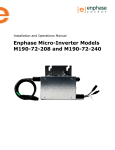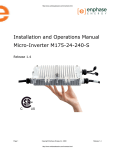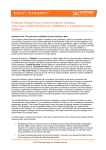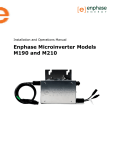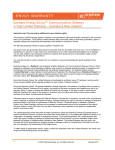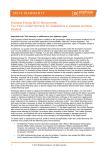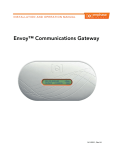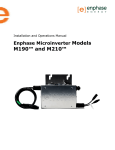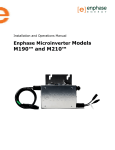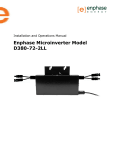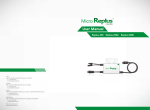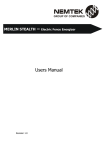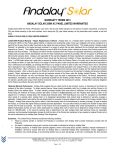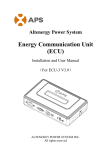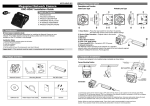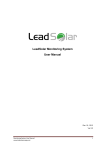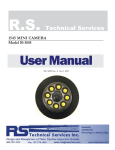Download Installation and Operations Manual Micro-Inverter M175-24-240-S
Transcript
Installation and Operations Manual Micro-Inverter M175-24-240-S Release 1.3 Page 1 Copyright Enphase Energy Inc. 2008 Release 1.3 Contact Information Enphase Energy Inc. 201 1St Street, Suite 111 Petaluma, CA 94952 Phone: 707-763-4784 Fax: 707-763-0784 www.enphaseenergy.com [email protected] Document Revision History Version 1.0 1.1 1.2 1.3 Page 2 Date 01/16/08 01/30/08 02/25/08 04/15/08 Comments Released General edits Final release edits Updated Technical Data tables Copyright Enphase Energy Inc. 2008 Release 1.3 Table of Contents Document Revision History ................................................................... 2 Table of Contents ................................................................................ 3 IMPORTANT SAFETY INSTRUCTIONS ...................................................... 4 1 Introduction – The Enphase Micro-Inverter System ............................. 5 2 Installation Instructions ................................................................... 6 Step 1 - Install the AC Branch Circuit Junction Box .............................. 7 Step 2 - Attach the Enphase Micro-Inverters to the Racking .................. 7 Step 3 - Connecting the Enphase Micro-Inverter Wiring Harnesses ......... 7 Step 4 - System Grounding .............................................................. 8 Step 5 - Enphase Installation Map and Connecting the PV Modules ......... 8 3 Commissioning ............................................................................... 9 4 Operating Instructions ................................................................... 10 5 Troubleshooting ........................................................................... 10 General Micro-Inverter Error Reporting ............................................ 10 Troubleshooting Suggestions for inoperable Micro-Inverters ................ 11 Disconnecting the Enphase Micro-Inverter from the PV Module ............ 11 6 Technical Data ............................................................................. 12 M175-24-240-S Micro-Inverter Operating Parameters ........................ 12 Voltage and Frequency Limits for Utility Interaction ........................... 13 7 Appendix ..................................................................................... 15 Limited Warranty .......................................................................... 15 Quick Installation Guide ................................................................. 17 Enphase Installation Map ............................................................... 18 Page 3 Copyright Enphase Energy Inc. 2008 Release 1.3 IMPORTANT SAFETY INSTRUCTIONS SAVE THESE INSTRUCTIONS This manual contains important instructions that shall be followed during installation and maintenance of the Enphase Micro-Inverter. To reduce the risk of electrical shock, and to ensure the safe installation and operation of the Enphase Micro-Inverter, the following safety symbols have been placed throughout this document to indicate dangerous conditions and important safety instruction. WARNING: This indicates a fact or feature very important for the safety of the user and/or which can cause a serious hardware failure if not applied appropriately. Use extreme caution when performing this task. NOTE: This indicates a feature that is important for optimal system operation. Follow these instructions closely. SAVE THESE INSTRUCTIONS ! All electrical installations shall be done in accordance with all local electrical codes and the National Electrical Code (NEC), ANSI/NFPA 70. ! Installations and replacement of Micro-Inverters shall only be performed by qualified personnel. ! The Enphase Micro-Inverter contains no user serviceable parts. Please return the unit to Enphase for maintenance. Tampering with or opening the Enphase Micro-Inverter will void the warranty. ! Before installing or using the Enphase Micro-Inverter, please read all instructions and cautionary markings in the technical description and on the Enphase Micro-Inverter system and the PV-array. ! Connecting the Enphase Micro-Inverter to the electrical utility grid must only be done after receiving prior approval from the utility company. ! The body of the Enphase Micro-Inverter is the heat sink and can reach a temperature of 80!C. To reduce risk of burns, do not touch ! Do NOT disconnect the PV module from the Enphase Micro-Inverter without first removing AC power. NOTE: The Enphase Micro-Inverter Warranty Terms and Conditions may be found in the Appendix section of this manual. Page 4 Copyright Enphase Energy Inc. 2008 Release 1.3 1 Introduction – The Enphase Micro-Inverter System The Enphase Micro-Inverter system is the world’s most technologically advanced inverter system for use in utility interactive applications. This manual details the safe installation and operation of the Enphase Micro-Inverter. The three key elements of an Enphase Micro-Inverter System are: 1) the Enphase Micro-Inverter, 2) the Energy Management Unit (Emu), and 3) the Enlighten web based analytics and visualization. All three elements are highly integrated to provide a comprehensive energy production and management system. The Enphase Micro-Inverter System maximizes energy production from your photovoltaic array. Each Enphase Micro-Inverter is individually connected to each PV module in your array. This unique configuration means that an individual Maximum Peak Power Point Tracker (MPPT) controls each PV module. This insures that the maximum power available from each PV module is exported to the utility grid regardless of the performance of the rest of the PV modules in the array which may be affected by shading, soiling, orientation, module mismatch, etc. The result is maximum energy production from the total PV system. Micro-Inverter systems are inherently more reliable than centralized or string inverters. The distributed nature of the Micro-Inverter System insures that there is no single point of failure in the PV system. Enphase Micro-Inverters are designed to operate at full power at temperatures as high as 55!C (150!F). The inverter housing is designed for outdoor installation and complies to the NEMA6 environmental enclosure rating standard: NEMA6 rating definition: Indoor or outdoor use primarily to provide a degree of protection against hose-directed water, and the entry of water during occasional temporary submersion at a limited depth and damage from external ice formation. Solar systems using Enphase Micro-Inverters are extremely simple to design and install. There are no string calculations needed. Individual PV modules may be installed in any combination of module quantity, type, age and orientation. There are no cumbersome centralized or string inverters to install. Each Micro-Inverter quickly mounts on the PV racking, directly beneath each PV module. Low voltage DC wires connect from the PV module directly to the co-located Micro-Inverter, eliminating the risk of personnel exposure to lethal 600Vdc power. The Energy Management Unit (Emu) communications gateway is installed by simply plugging it into any convenient 120Vac wall socket. The full network of Enphase Micro-Inverters will automatically begin reporting to the Enphase Enlighten web server. The Enlighten analytics software lets you know not only the immediate and historical system performance trends, but also informs you when the PV system is not performing as expected. These are just a few of the advantages of the Enphase Micro-Inverter System that will provide tremendous time, material and cost savings, while maximizing energy production from your PV system and providing better ROI on your solar investment. Page 5 Copyright Enphase Energy Inc. 2008 Release 1.3 2 Installation Instructions WARNING: Before installing the Enphase Micro-Inverter, read all instructions and cautionary markings in the user manual and on the Enphase Micro-Inverter and the photovoltaic array. WARNING: All electrical installations shall be done in accordance with all local electrical codes and the National Electrical Code (NEC), ANSI/NFPA 70. WARNING: Connecting the Enphase Micro-Inverter to the electrical utility grid must be done only after receiving prior approval from the utility company. WARNING: Only qualified personnel must connect the Enphase MicroInverter to the electrical utility grid. WARNING: Risk of electric shock. Normally grounded conductors may be ungrounded and energized when a ground fault is indicated. WARNING: This unit or system is provided with fixed trip limits and shall not be aggregated above 30kW on a single Point of Common Connection. Installation of the Enphase Micro-Inverter System involves the following key steps: 1 Installing the AC branch circuit junction box 2 Attaching the Enphase Micro-Inverters to the racking 3 Connecting the Enphase Micro-Inverter wiring harnesses 4 System Grounding 5 Enphase Installation map and Connecting the PV modules NOTE: It is recommended that all Micro-Inverters be installed and all system inter-wiring connections completed prior to installing the PV modules. Please refer to the Quick Install Guide at the end of this document for a diagram of the Enphase Micro-Inverter System. Each step of these installation instructions is numerically referenced in the Quick Install Guide drawing. Page 6 Copyright Enphase Energy Inc. 2008 Release 1.3 WARNING: DO NOT connect Enphase Micro-Inverters to the utility grid or energize the AC circuit(s) until after completing Step 5 of these installation instructions. Step 1 - Install the AC Branch Circuit Junction Box ! Mount the Enphase Adaptor Plate at a suitable location on the PV racking system (typically at the end of a row of modules). ! Install an appropriate junction box with a 15A AC disconnect switch (optional as required by local code requirements) to the adaptor plate. ! Connect the open wire end of the Enphase AC interconnect cable into the junction box using an appropriate gland or strain relief fitting. ! Route the continuous Grounding Electrode Conductor (GEC) through the AC branch circuit junction box. Check local code requirements for the gauge of the GEC. WARNING: Use electrical system components approved for wet locations only. NOTE: Please refer to the Enphase website for a list of approved PV module racking systems. NOTE: The Enphase M175-24-240-S Micro Inverter is designed to operate with most 72-cell PV module configurations; sometimes referred to as “24V modules”. Step 2 - Attach the Enphase Micro-Inverters to the Racking ! Mark the approximate centers of each PV module on the racking system. ! Mount one Micro-Inverter at each of these locations using hardware recommended by your PV racking vendor. WARNING: Allow a minimum of ¾” spacing between the top of the roof and the bottom of the Micro-Inverter. Enphase also recommends 1” of spacing between the back of the PV module and the top of the inverter. Step 3 - Connecting the Enphase Micro-Inverter Wiring Harnesses ! Page 7 Each Micro-Inverter has been provided with two, 36-inch long AC wire harnesses with multi-pin connectors (the DC input wires are approximately 6 inches long and are terminated with single pole MC connectors). The AC connectors are oppositely sexed, so that multiple Copyright Enphase Energy Inc. 2008 Release 1.3 inverters can be connected together to form one continuous AC branch circuit. ! Plug the AC connector of one Micro-Inverter into the connector of the next Micro-Inverter to form a continuous AC branch circuit. Please check the Micro-Inverter rating label for the maximum allowable number of Micro-Inverters on one AC branch circuit. ! Install a protective end cap (included in the Enphase Installation Kit) on the open AC connector of the last Micro-Inverter in the AC branch circuit. WARNING: Do NOT exceed the maximum number of Micro-Inverters in an AC branch circuit, as displayed on the unit-rating label. Each Micro-Inverter AC branch circuit must be sourced from a dedicated branch circuit protected by a 15A maximum breaker. WARNING: Unused AC Micro-Inverter wire harness connectors may be live when the system is energized by the utility system. Make sure protective end caps have been installed on all unused AC connectors. NOTE: Be sure to size the AC wire gauge to account for voltage drop between the AC branch circuit junction box and the point of utility inter-connection. Step 4 - System Grounding ! Each Enphase Micro-Inverter has been provided with a ground clip that can accommodate a 6-10 AWG conductor. ! Route a continuous Grounding Electrode Conductor through each of the Micro-Inverters and AC branch circuit junction box to the NEC approved AC grounding electrode. Note: The AC output neutral is not bonded to ground inside the MicroInverter. Step 5 - Enphase Installation Map and Connecting the PV Modules The Enphase Installation Map is designed to be a diagrammatic representation of the physical location of each Enphase Micro-Inverter in your PV installation. This information will be used by Enphase to provide you with detailed information about the performance of your PV system and graphically visualize your PV system on the Enphase Enlighten website. A simple rectangular matrix has been included in the Appendix of this manual for your use. Feel free to provide your own matrix layout if a larger or more intricate installation map is required. Page 8 Copyright Enphase Energy Inc. 2008 Release 1.3 3 ! Each Enphase Micro-Inverter has two removable labels located on the top cover. Peel one of the labels from each Enphase Micro-inverter and affix it to the respective location on the Enphase installation map. ! Send the installation map to Enphase after completion. Enphase prefers to receive a digital copy of the installation map via an upload to the Enlighten web site during installation set up or via email. If digital scanning of the map is not possible, please provide the map via fax or mail. See the contact information at the beginning of this manual for a fax number, email address, and mailing address. It is recommended that you make a copy of the installation map if you will be sending in the original. ! Enphase will create a graphical representation of your PV system on the Enlighten website. The Enlighten web server will provide you with detailed information regarding the performance of your PV system (please go to www.enphaseenergy.com for more information on the Enphase Enlighten communication, visualization and analytics system). ! Installation maps and examples can be downloaded from www.enphaseenergy.com. An example may also be found in the Appendix section of this manual. ! Finally, mount the PV modules above their corresponding MicroInverters. Each Micro-Inverter has been provided with two oppositely sexed Multi-Contact DC plus and minus connectors. ! First connect the positive DC wire from the PV module to the positive DC connector (female socket) of the Micro-Inverter. Then connect the negative DC wire from the PV module to the negative DC connector (male socket) of the Micro-Inverter. Repeat for all modules, MicroInverters Commissioning WARNING: Connecting the Enphase Micro-Inverter to the electrical utility grid must only be done after receiving prior approval from the utility company. WARNING: Only qualified personnel must connect the Enphase MicroInverter to the electrical utility grid. WARNING: Ensure that all AC and DC wiring is correct. Ensure that none of the AC and DC wires are pinched or damaged. Ensure that all junction boxes are properly closed. Note: Each Micro-Inverter will beep six times to indicate normal startup operation once AC or DC power is applied. Page 9 Copyright Enphase Energy Inc. 2008 Release 1.3 Follow these procedures to commission the Enphase Micro-Inverter PV system: 4 5 1 Turn ON the AC disconnect on each Micro-Inverter AC branch circuit junction box. 2 Turn ON the main utility-grid AC circuit breaker. 3 Your system will start producing power after a five-minute wait time. 4 Operation and production can be verified by reading the display on the LCD panel of the Energy management unit (Emu) communications gateway. 5 Please refer to the Emu User Manual for information on installation and operation of the Emu. Operating Instructions ! When the Enphase Micro-Inverter is powered on, you will hear six beeps indicating proper start–up ! In the event of a GFDI failure, you will hear a 5-minute long continuous tone when the fault occurs. This will repeat when AC and DC power are cycled to the Micro-Inverter. ! Proper operation of the Enphase Micro-Inverters can be verified via the Emu. Troubleshooting Adhere to all the safety measures described throughout this manual. Enphase recommends the following troubleshooting steps in the event your PV system does not operate correctly: WARNING: The Enphase Micro-Inverter contains no user serviceable parts. Please return the unit to Enphase for maintenance. General Micro-Inverter Error Reporting Page 10 ! Normal Operation: Listen for six short beeps when AC or DC power is first applied to the Micro-Inverter. This indicates normal Micro-Inverter operation. ! GFDI Fault: A long constant tone after AC and DC power has been cycled, indicates the Micro-Inverter has detected a ground fault (GFDI) error. This tone will sound for 5 minutes, after which the Micro-Inverter will remain silent. The fault will continue to be reported by the EMU. The error can only be cleared via the Emu after the ground fault condition has been remedied. Please refer to the user manual of the EMU for more detailed instructions. ! Other Faults: All other faults are reported to the Emu. Please refer to this manual for a list of additional faults and troubleshooting procedures. Copyright Enphase Energy Inc. 2008 Release 1.3 WARNING: Troubleshooting of the PV array or Micro-Inverter system should be done by qualified personnel only. WARNING: Never disconnect the DC wire connectors under load. Ensure that no current is flowing in the DC wires prior to disconnecting. WARNING: Always disconnect AC power before disconnecting the PV module wires from the Enphase Micro-Inverter. WARNING: The Enphase Micro-Inverters are powered both by AC power from the utility grid and DC power from the PV modules. Make sure you disconnect both the AC and the DC connections and reconnect either AC or DC power to hear the six start-up beeps. Troubleshooting Suggestions for inoperable Micro-Inverters ! Check the connection to the utility grid. Verify the utility voltage and frequency are within allowable ranges shown in the Technical Data section of this manual. Verify utility power is present at the inverter in question by removing AC, then DC power. Never disconnect the DC wires while the MicroInverter is producing power. Re-connect the AC power conductor and listen for 6 short beeps. ! Check the AC branch circuit interconnection harness between all the MicroInverters. Verify each inverter is energized by the utility grid with the previous procedure. ! Check the DC connections between the Micro-Inverter and the PV module. ! Verify the PV module DC voltage is within the allowable range shown in the Technical Data section of this manual. ! Make sure that all the AC switches in the junction boxes are functioning properly and are closed. ! If the problem persists, please call customer support at Enphase Energy. Disconnecting the Enphase Micro-Inverter from the PV Module To insure the Micro-Inverter is not disconnected from the PV modules under load, adhere to the following procedure in the order shown: Page 11 1 Turn off the AC disconnect on the AC branch circuit junction box. 2 Turn off the utility-grid AC circuit breaker. 3 Disconnect the AC branch circuit wire harness connector(s). 4 Using a DC current probe, verify there is no current flowing in the DC wires between the PV module and the Micro-Inverter. 5 If there is measurable DC current, cover the PV module connected to the Micro-Inverter with an opaque material. Copyright Enphase Energy Inc. 2008 Release 1.3 6 6 Disconnect the PV module DC wire connectors from the Micro-Inverter. 7 Remove the Micro-Inverter from the PV array racking. Technical Data WARNING: It is required to match the DC operating voltage range of the PV module with the allowable input voltage range of the Enphase Micro-Inverter. WARNING: The maximum open circuit voltage of the PV module may not exceed the specified maximum input voltage of the Enphase MicroInverter. The Enphase M175-24-240-S Micro-Inverter has been specifically optimized for operation with most 72-cell (24V nominal) PV module configurations. Be sure to verify the voltage and current specifications of your PV module match with those of the Micro-Inverter. The output voltage and current of the PV module depends on the quantity, size and temperature of the PV cells, as well as the solar insolation on each cell. The highest PV module output voltage occurs when the temperature of the cells is the lowest and the module is at open circuit (not operating). The maximum short circuit current rating of the module must be equal to or less than the maximum input DC short circuit current rating of the Micro-Inverter. A list of compatible PV modules is maintained on the Enphase website (www.enphaseenergy.com). M175-24-240-S Micro-Inverter Operating Parameters Topic Unit Min DC Operating Parameters MPPT voltage range V 25 Maximum DC input voltage V Maximum DC input short circuit A current Maximum DC input current A Ground fault protection mA AC Operating Parameters Maximum AC output Power (at 65 W 175 deg. C) Output power factor 0.85 Nominal AC output voltage range Vrms 211 Extended AC output voltage range Vrms 206 Maximum AC output current mA Nominal AC output frequency range Hz 59.3 Extended AC output frequency range Hz 59.2 Page 12 Copyright Enphase Energy Inc. 2008 Typical Max 32 40 54 10 8 1000 0.99 240 240 750 60 60 1 264 269 830 60.5 60.6 Release 1.3 M175-24-240-S Micro-Inverter Operating Parameters Topic Unit Min Typical Max Maximum AC output over current A 15 protection Maximum AC output fault current A/ms 20/0.1 and duration AC Voltage trip limit accuracy % "2.5 Frequency trip limit accuracy Hz ±0.1 Trip time accuracy ms ±33 Miscellaneous Operating Parameters Maximum inverters per AC branch 1 16 circuit Peak inverter efficiency % 95.0 CEC weighted efficiency % 94.5 Nominal MPP tracking efficiency % 99.6 Total Harmonic Distortion % 2.5 5 Operating temperature range !C -25 65 Night Tare Loss nW 580 Storage temperature range !C -25 65 Weight Lbs < 4.0 Features Dimensions (approximate) 11” x 5 ¾” x 1 ½” Enclosure environmental rating NEMA6 Cooling Convective – no fan Communication Powerline Standard warranty term 10 years Compliance UL1741, IEEE1547, FCC Part 15 Class B Voltage and Frequency Limits for Utility Interaction Simulated utility source Condition A B C D E F Page 13 Voltage (V) Frequency (Hz) < 0.50 V Typical 0.50 VTypical ! V < 0.88 VTypical 1.10 VTypical < V < 1.20 VTypical 1.20 VTypical ! V Rated Rated Rated Rated Maximum time (sec) (cycles) at 60 Hz before cessation of current to the simulated utility 0.16 2 Rated 1 Rated f > 60.5 f < (59.8 – 57.0) 0.16 0.16 0.16 – 300 Copyright Enphase Energy Inc. 2008 Release 1.3 G Page 14 Rated f < 57.0 Copyright Enphase Energy Inc. 2008 0.16 Release 1.3 7 Appendix Limited Warranty Enphase Energy Inc. ("Enphase") has developed a highly reliable Micro-Inverter that is designed to withstand normal operating conditions when used for its originally intended purpose in compliance with the Enphase User Manual supplied with the originally shipped system. The Enphase limited warranty (“Limited Warranty”) covers defects in workmanship and materials of the Enphase Micro-Inverter (“Defective Product”) for a period of ten (10) years from the date of original purchase of such Micro-Inverter at point of sale to the original end user customer (the “Warranty Period”). During the Warranty Period, Enphase will, at its option, repair or replace the Defective Product free of charge, provided that Enphase through inspection establishes the existence of a defect that is covered by the Limited Warranty. Enphase will, at its option, use new and/or reconditioned parts in repairing or replacing the Defective Product. Enphase reserves the right to use parts or products of original or improved design in the repair or replacement of Defective Product. If Enphase repairs or replaces a Defective Product, the Limited Warranty continues on the repaired or replacement product for the remainder of the original Warranty Period or ninety (90) days from the date of Enphase’s return shipment of the repaired or replacement product, whichever is later. The Limited Warranty covers both parts and labor necessary to repair the Defective Product, but does not include labor costs related to un-installing the Defective Product or re-installing the repaired or replacement product. The Limited Warranty also covers the costs of shipping repaired or replacement product from Enphase, via a non-expedited freight carrier selected by Enphase, to locations within the United States (including Alaska and Hawaii) and Canada, but not to other locations outside the United States or Canada. The Limited Warranty does not cover, and Enphase will not be responsible for, shipping damage or damage caused by mishandling by the freight carrier and any such damage is the responsibility of the freight carrier. To obtain repair or replacement service under this Limited Warranty, the customer must comply with the following policy and procedure: Page 15 ! All Defective Product must be returned with a Return Merchandise Authorization Number (RMA) which customer must request from Enphase. Before requesting the RMA, however, the customer should contact an Enphase technical support representative to evaluate and troubleshoot the problem while the Enphase Micro-Inverter is in the field, since many problems can be solved in the field. ! If in-field troubleshooting does not solve the problem, Customer may request the RMA number, which request must include the following information: ! Proof-of-purchase of the Defective Product in the form of (1) the dated purchase receipt from the original purchase of the product at point of sale to the end user, or (2) the dated dealer invoice or purchase receipt showing original equipment manufacturer (OEM) status, or (3) the dated invoice or purchase receipt showing the product exchanged under warranty ! Model number of the Defective Product Copyright Enphase Energy Inc. 2008 Release 1.3 ! Serial number of the Defective Product ! Detailed description of the defect ! Shipping address for return of the repaired or replacement product ! All Defective Product authorized for return must be returned in the original shipping container or other packaging that is equally protective of the product ! The returned Defective Product must not have been disassembled or modified without the prior written authorization of Enphase The Limited Warranty does not cover normal wear and tear of Enphase MicroInverters or costs related to the removal, installation, or troubleshooting of the customer's electrical systems. The Limited Warranty does not apply to, and Enphase will not be responsible for, any defect in or damage to any Enphase Micro-Inverter: (1) that has been misused, neglected, tampered with, altered, or otherwise damaged, either internally or externally; (2) that has been improperly installed, operated, handled or used, including use under conditions for which the product was not designed, use in an unsuitable environment, or use in a manner contrary to the Enphase User Manual or applicable laws or regulations; (3) that has been subjected to fire, water, generalized corrosion, biological infestations, acts of God, or input voltage that creates operating conditions beyond the maximum or minimum limits listed in the Enphase Micro-Inverter specifications, including high input voltage from generators or lightning strikes; (4) that has been subjected to incidental or consequential damage caused by defects of other components of the solar system; or (5) if the original identification markings (including trademark or serial number) of such Micro-Inverter have been defaced, altered, or removed. The Limited Warranty does not extend beyond the original cost of the Enphase Micro-Inverter. THE LIMITED WARRANTY IS THE SOLE AND EXCLUSIVE WARRANTY GIVEN BY ENPHASE AND, WHERE PERMITTED BY LAW, IS MADE EXPRESSLY IN LIEU OF ALL OTHER WARRANTIES, EXPRESS OR IMPLIED, STATUTORY OR OTHERWISE, INCLUDING, WITHOUT LIMITATION, WARRANTIES OF TITLE, QUALITY, MERCHANTABILITY, FITNESS FOR A PARTICULAR PURPOSE OR NON-INFRINGEMENT OR WARRANTIES AS TO THE ACCURACY, SUFFICIENCY OR SUITABILITY OF ANY TECHNICAL OR OTHER INFORMATION PROVIDED IN MANUALS OR OTHER DOCUMENTATION. IN NO EVENT WILL ENPHASE BE LIABLE FOR ANY SPECIAL, DIRECT, INDIRECT, INCIDENTAL OR CONSEQUENTIAL DAMAGES, LOSSES, COSTS OR EXPENSES HOWEVER ARISING, WHETHER IN CONTRACT OR TORT, INCLUDING WITHOUT LIMITATION ANY ECONOMIC LOSSES OF ANY KIND, ANY LOSS OR DAMAGE TO PROPERTY, OR ANY PERSONAL INJURY. To the extent any implied warranties are required under applicable law to apply to the Enphase Micro-Inverter, such implied warranties shall be limited in duration to the Warranty Period, to the extent permitted by applicable law. Some states and provinces do not allow limitations or exclusions on implied warranties or on the duration of an implied warranty or on the limitation or exclusion of incidental or consequential damages, so the above limitation(s) or exclusion(s) may not apply. This Limited Warranty gives the customer specific legal rights, and the customer may have other rights that may vary from state to state or province to province. Page 16 Copyright Enphase Energy Inc. 2008 Release 1.3 Quick Installation Guide Page 17 Copyright Enphase Energy Inc. 2008 Release 1.3 Enphase Installation Map Page 18 Copyright Enphase Energy Inc. 2008 Release 1.3


















